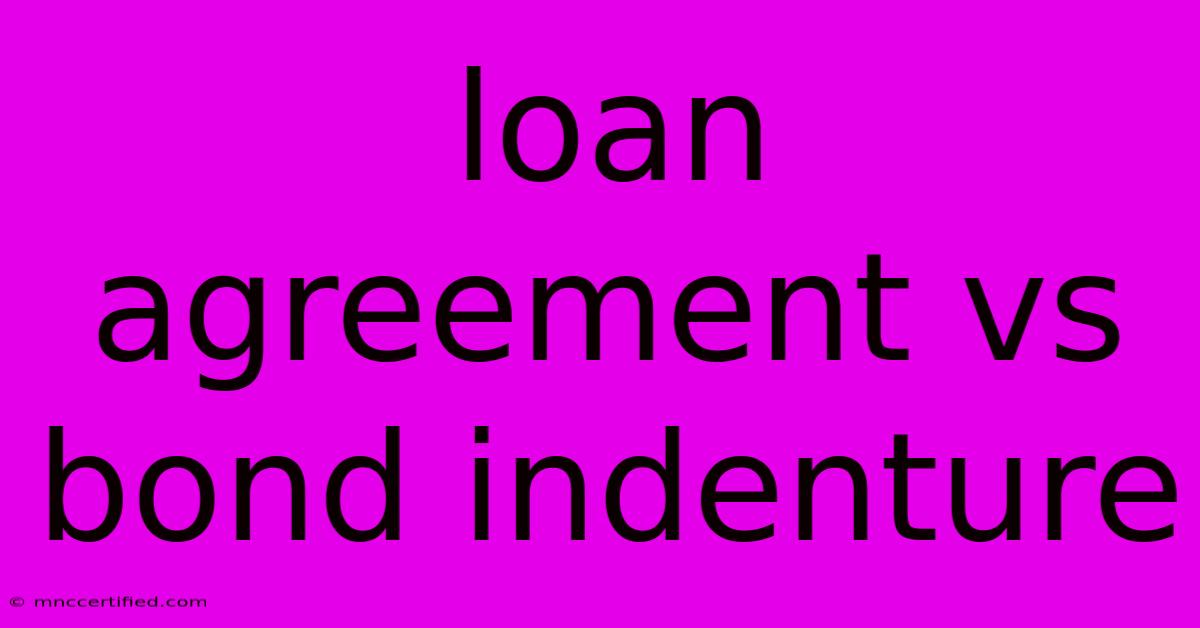Loan Agreement Vs Bond Indenture

Table of Contents
Loan Agreement vs. Bond Indenture: Understanding the Key Differences
For businesses seeking capital, understanding the nuances between a loan agreement and a bond indenture is crucial. While both involve borrowing money, they differ significantly in structure, legal implications, and the overall process. This article will delve into the core distinctions, helping you navigate these complex financial instruments.
What is a Loan Agreement?
A loan agreement is a contract between a lender (e.g., a bank, credit union, or private investor) and a borrower (e.g., a company, individual). It outlines the terms of a loan, including the principal amount, interest rate, repayment schedule, and any collateral securing the loan. Loan agreements are typically simpler and less formal than bond indentures, often used for smaller sums of money or loans between parties with an existing relationship.
Key Features of a Loan Agreement:
- Direct Lender-Borrower Relationship: The relationship is typically bilateral, meaning only two parties are involved.
- Negotiated Terms: The terms of the loan are directly negotiated between the lender and borrower. This allows for flexibility and customization.
- Simpler Structure: Loan agreements tend to be less complex and shorter than bond indentures.
- Limited Transferability: The loan agreement is generally not easily transferable to a third party.
When to Use a Loan Agreement?
Loan agreements are best suited for:
- Small to Medium-Sized Loans: They are efficient for loans where the administrative costs of a more complex structure would outweigh the benefits.
- Loans Between Related Parties: Loans between family members or business associates often utilize loan agreements.
- Situations Requiring Customized Terms: The flexibility of a loan agreement makes it ideal when specific terms are needed.
What is a Bond Indenture?
A bond indenture, also known as a trust indenture, is a legal agreement between a bond issuer (e.g., a corporation or government) and a trustee acting on behalf of the bondholders. It details the terms of a bond issue, including the principal amount, interest rate, maturity date, and other covenants (promises) the issuer makes to the bondholders. Bond indentures are considerably more complex than loan agreements, reflecting the larger sums of money and the involvement of numerous bondholders.
Key Features of a Bond Indenture:
- Multiple Parties Involved: The issuer, trustee, and numerous bondholders are involved.
- Standardized Terms: While some aspects can be negotiated, the terms are largely standardized to protect bondholders.
- Complex Structure: Bond indentures are legally complex documents requiring expert legal and financial advice.
- Transferability: Bonds issued under an indenture are easily transferable in the secondary market.
- Trustee's Role: The trustee acts as an intermediary, ensuring the issuer adheres to the terms of the indenture. They represent the interests of the bondholders.
When to Use a Bond Indenture?
Bond indentures are used for:
- Large-Scale Debt Financing: They are the standard for raising significant capital through public or private bond offerings.
- Public Bond Issues: When a company or government needs to raise capital through a public bond offering, a bond indenture is required.
- Protecting Bondholders: The complex structure and the role of the trustee protect the rights and interests of bondholders.
Loan Agreement vs. Bond Indenture: A Comparison Table
| Feature | Loan Agreement | Bond Indenture |
|---|---|---|
| Parties | Lender and Borrower | Issuer, Trustee, and Bondholders |
| Complexity | Relatively Simple | Highly Complex |
| Terms | Negotiated, Flexible | Standardized, with some flexibility |
| Amount | Typically Smaller | Typically Larger |
| Transferability | Limited | Easily Transferable in the secondary market |
| Legal Structure | Contract between two parties | Trust agreement involving multiple parties |
| Security | May or may not be secured by collateral | Often secured by assets of the issuing entity |
Conclusion
Choosing between a loan agreement and a bond indenture depends entirely on the specific circumstances of the borrowing. Understanding the key differences outlined above is essential for making an informed decision and ensuring the chosen financial instrument aligns with your needs and legal requirements. Consulting with legal and financial professionals is highly recommended, especially when dealing with bond indentures due to their complexity.

Thank you for visiting our website wich cover about Loan Agreement Vs Bond Indenture. We hope the information provided has been useful to you. Feel free to contact us if you have any questions or need further assistance. See you next time and dont miss to bookmark.
Featured Posts
-
Oats Alabama Freshman Climbing Draft Boards
Nov 20, 2024
-
Jailbreak Trading Value List 2023
Nov 20, 2024
-
Fossil Fuel Ties Prize Money Refusal
Nov 20, 2024
-
Alabamas Philon Nba Draft Stock Up
Nov 20, 2024
-
Sleeping Bags Sierra Trading Post
Nov 20, 2024